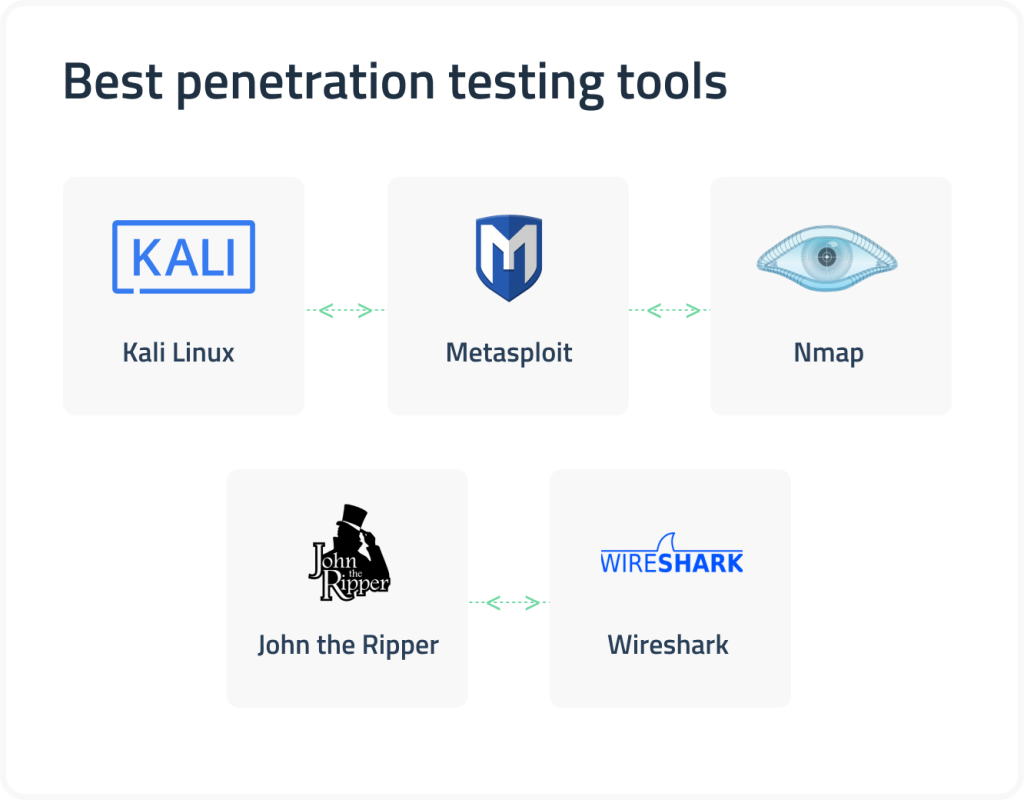
Best pen testing tools 2023-2024: Pro services for your cybersecurity
As cyber threats continue to rise, companies constantly seek new methods to protect their web applications. One of the best techniques is penetration testing, which has become crucial to any protection strategy.
Penetration testing, also called pen test or pen testing, is gaining popularity steadily. According to Markets and Markets, the market for pen testing will grow from $1.7 billion in 2020 to $4.5 billion by 2025. We are convinced you need to know more about it!
Keep reading to learn everything you need about pen testing, its main types, and the top penetration testing tools to use.
Need penetration testing services? Check what we offer.
What is penetration testing?
As we have mentioned, companies worldwide are facing an increasing number of threats that are affecting their critical infrastructure. In 2022, there was a record-breaking surge in CVE data, with over 25,000 published throughout the year. On average, that means about 68.75 CVEs were published every day.
Penetration test refers to the legitimate verification of an IT system’s security from an attacker’s perspective (colloquially often referred to as a hacker). Similar or even the same hacking methods and tools are used in such a test.
A penetration test is always only a snapshot. Digital processes and the associated systems are constantly changing. On the one hand, new security gaps are found continuously; on the other hand, new security problems can also unintentionally arise due to updates or further developments. The result of a penetration test can therefore give different results at different times (both positive and negative).
For this reason, it is important to understand that penetration tests are only one of many necessary measures to increase the security of an IT component and must never be used as the only measure. Nevertheless, a penetration test is highly significant in evaluating security. Recent research by Core Security found that 97% of respondents consider it indispensable for their safety.
Related article:
What is the primary purpose of penetration testing?
Why go for a penetration test?
A penetration test provides an overview of the state of information security of the test object at a particular time.
First, it should be checked whether the measures are already taken to ensure quality and security are sufficient; at the same time, possible vulnerabilities should be uncovered that may only exist from the point of view of an attacker and may have been overlooked from a different perspective.
The construction and maintenance of IT infrastructures is always a repetitive, cyclical process, constantly changing through new technologies, concepts, and procedures. Penetration tests should, therefore, also be carried out repeatedly at regular intervals.
What can be tested?
Everything that has to do directly or indirectly with IT systems can be tested. As a rule, however, such tests focus on applications accessible to a broad mass of users due to their task and purpose and are therefore exposed to potentially frequent attacks.
Most common things to be tested
- Internally or externally accessible servers and networks
- Web applications
- Smartphone apps
- REST/SOAP APIs
- Wireless access and connections (WLAN, Bluetooth, RFID, 6LoWPAN)
But social engineering, such as performing phishing simulations, can also fall within the scope of the penetration test, depending on the definition.
The procedure of a penetration test
The procedure consists of several phases. Since there are no general standards in this area, these phases may differ depending on the provider. However, there are often only minor differences in terms of content.
As a self-contained process, a penetration test in this form can be easily integrated with existing workflows or processes and thus sustainably increase the general safety level of a product in its life cycle.
Penetration test process
Preparation
In the preparation phase, the framework conditions and the subject matter of the penetration test are discussed with the client. It must be recorded in detail what should be tested and which methods are used. Since productive systems are often tested, it must be considered, for example, that the penetration test does not restrict regular operation. A test period should also be determined in advance.
Gathering information
The practical work of the penetration test begins. The client will provide the required information on the test object if it is a white box test. If a black box test occurs, the examiner must obtain the information independently with suitable tools or by hand. As a rule, both automated and manual methods are used interchangeably.
Information evaluation
The collected information is evaluated and examined for possible attack vectors. This phase creates the basis for the further practical course of the penetration test.
Practical tests
This phase is the core component of a penetration test. The identified weak points are checked for theoretic usability, and further tests are carried out. As a rule, the practical tests go far beyond the attack vectors identified in the previous phases and cover many other common safety problems of the test object.
Reporting
In the final phase, a report is created for the client. It contains detailed information on the individual test points, the methodology used, and the safety problems found. The security problems are classified according to their criticality (low, medium, high, and critical) and recommendations for their correction.
Night test (optional)
A night test focuses only on the safety problems found in the penetration test and is intended to evaluate whether the issues documented in the report have been properly eliminated. However, it must be noted that correcting safety deficiencies can also lead to new gaps. Therefore, a new, complete penetration test is always recommended for more extensive changes.
Types of pentesting tools
Let’s take a look at the most common penetration testing tools. Depending on your goals, you can select from the list.
Penetration-testing-as-a-service
Penetration Testing as a Service (PTaaS) is a platform that provides regular and affordable access to penetration tests. It’s important not to confuse it with cloud pen testing. PTaaS enables penetration testing service providers and client organizations to collaborate easily on demand. Organizations use PTaaS to identify and fix vulnerabilities regularly.
Previously, penetration testing was a complex process done through contracts, and organizations could only afford to do it once or twice a year. With PTaaS, organizations can conduct penetration tests daily or even after every code change. While cloud penetration testing focuses on finding security weaknesses in specific cloud environments, PTaaS allows for more frequent testing across all environments.
Open-source pen test tools
There are different pen testing tools available that can be used to analyze, simulate an attack, and report on the security of an IT environment. Many of these tools are open-source, which means any security team can use them.
It’s worth noting that some previously open-source scanning tools, like Metasploit and Burp Suite, have become commercial products. They still offer free versions but with cut functionality. Regardless of the tool you choose, it’s crucial to ensure that it is actively supported and regularly updated.
Web app pen testing
A web application penetration test aims to find security weaknesses or vulnerabilities in web applications, including the source code, database, and relevant backend network. The process typically involves three phases:
Phase 1. Reconnaissance: gathering information about the application, such as the operating system and resources it uses.
Phase 2. Discovery: attempting to identify vulnerabilities in the application.
Phase 3. Exploitation: utilizing the detected vulnerabilities to gain unauthorized access to the application and its data.
The results of a web application pentest provide information about identified vulnerabilities and any successful exploitation. This data helps organizations prioritize vulnerabilities and determine how to apply necessary fixes.
Mobile app pen testing
A mobile application penetration test focuses on identifying vulnerabilities specifically in mobile applications, excluding servers and mobile APIs.
Two main types of assessments involved are:
- Static analysis involves extracting elements such as source code and metadata for reverse engineering. The purpose is to analyze the application’s structure and identify potential vulnerabilities.
- Dynamic analysis: This involves assessing the application’s behavior during runtime. Testers may attempt to extract data from the device’s RAM or bypass security controls to uncover vulnerabilities.
These two test approaches are commonly performed during a mobile application pentest.
Cloud pen tests
Cloud penetration testing involves identifying and exploiting security vulnerabilities in your cloud infrastructure by conducting controlled cyber attacks. This process adheres to strict guidelines granted by cloud service providers like AWS and GCP. The objective is to detect and address vulnerabilities before malicious entities can exploit them.
In simple terms, penetration testing refers to offensive security tests conducted on a system, service, or network to identify security weaknesses. Cloud penetration testing specifically focuses on simulating attacks on your cloud services to assess their security measures.
Network pen tests
Network penetration testing is a security service that aims to identify flaws in networks, systems, hosts, and devices by intentionally using malicious techniques to test the network’s security responses. Simply put, businesses hire ethical hackers to find the weakest points by attempting to break into networks using any means necessary. Network penetration testing offers several benefits to businesses.
The top benefits of network pen tests include the following:
- Understanding network benchmarks: penetration testing provides insights into the strengths and weaknesses of your network’s security.
- Testing security controls: it assesses the effectiveness of your security controls by simulating real-world attack scenarios.
- Evaluating security posture: penetration testing evaluates the overall security stance of your network infrastructure.
- Identifying security flaws: it uncovers specific vulnerabilities and weaknesses that malicious actors could exploit.
- Assessing risk: penetration testing helps you understand your network’s potential dangers and prioritize mitigation efforts.
- Addressing security flaws: once identified, network security flaws can be managed and fixed to enhance overall security.
- Preventing breaches: by proactively identifying vulnerabilities, penetration testing helps prevent network and data breaches.
- Ensuring network and system security: regular penetration testing helps maintain a robust and secure network and system environment.
Penetration testing enables businesses to assess security controls, mitigate vulnerabilities, and proactively prevent data breaches.
Manual and automated pen testing
Both manual and automated penetration testing serve the same purpose but have different approaches. Manual testing involves human experts who assess system flaws and risks. They collect data, perform vulnerability assessments, launch exploits, and prepare detailed reports with corrective actions.
On the other hand, automated testing is faster, more efficient, and more reliable. It doesn’t require expert engineers and can be done by individuals with minimal knowledge.
Automated testing uses technology to do the job. In summary, manual testing relies on human expertise, while automated testing relies on machine capabilities to achieve the same objective.
What should you pay attention to when looking for pen testing tools or services?
| Pentest tools (must-have features) | Detailed reports Built-in vulnerability scanner Multi-system operability Password cracking capabilities CI/CD integration Remediation support Pentest certificate |
| Services (must-have expertise) | At least five years of experience in pen testing Certified test engineers Both automated and manual testing services |
Best penetration testing tools
We have finally approached the most exciting: the best pen testing tools to help drive your penetration testing efforts today. So, here they are: welcome the leaders!

Kali Linux
Kali Linux is meticulously optimized for offensive purposes, specifically as a penetration tester’s tool. While this penetration testing tool can be operated on dedicated hardware, it is more commonly employed through virtual machines on operating systems such as OS X or Windows. This configuration allows for greater flexibility and convenience.
Kali Linux comes preloaded with a comprehensive set of tools mentioned earlier and serves as the default operating system for most penetration testing scenarios. However, it’s important to note that Kali Linux is designed with a focus on offense rather than defense, making it potentially vulnerable if not appropriately secured.
This is why storing highly sensitive files or confidential information within a Kali Linux virtual machine is not recommended.
Metasploit
Why settle for simple exploitation when you can leverage the power of the Metasploit penetration testing tool? Aptly named, this versatile software serves as a crossbow in the arsenal of penetration testers. With Metasploit, testers can precisely aim at their targets, select suitable exploits, choose payloads, and launch attacks effectively.
Offering extensive automation capabilities, Metasploit significantly reduces the time and effort required for previously tedious tasks. It proudly claims the title of “the world’s most used penetration testing framework” and operates as an open-source project with commercial support from Rapid7.
Metasploit is an essential tool for defenders seeking to fortify their systems against potential attackers to ensure comprehensive security.
Nmap
Considered the granddaddy of port scanners, Nmap (short for network mapper) is an indispensable penetration testing software in the arsenal of testers. It serves the crucial purpose of identifying open ports and the services running on those ports. This information is invaluable during the reconnaissance phase, and Nmap is the most reliable tool for this task.
It is worth noting that despite occasional concerns raised by non-technical executives in corporate leadership positions regarding unknown entities conducting port scans on the enterprise network, Nmap itself is entirely legal to use. Conceptually, it can be likened to knocking on the front doors of residences within a neighborhood to determine if anyone is home.
Legitimate organizations, including insurance agencies, Internet cartographers like Shodan and Censys, and risk assessment providers like BitSight, regularly employ specialized port-scanning software (often Nmap’s competitors, such as Masscan or Zmap) to scan the entire range of IPv4 addresses.
This practice enables mapping the public security posture of both large and small enterprises. Nonetheless, it is crucial to acknowledge that malicious attackers also employ port scanning techniques, making it necessary to log and monitor such activities for future reference and analysis.
Check out our software testing and QA services for the insurance domain
John the Ripper
Contrary to its namesake’s gruesome reputation as a serial killer in Victorian London, John the Ripper, the software tool harbors a different purpose altogether. Rather than inflicting harm, this open-source password cracker excels in offline password cracking. Utilizing a word list of commonly used passwords, John the Ripper employs mutations by substituting characters like “a” with symbols like “@” or “s” with “5.”
By harnessing the computational power of a robust GPU, it relentlessly tests combinations until it successfully decrypts a password. Considering that most individuals employ short and simplistic passwords, John the Ripper frequently succeeds in breaking encrypted access info.
Wireshark
Wireshark, the ubiquitous network protocol analyzer, provides invaluable insights into the traffic traversing your network infrastructure. Although it is commonly employed to troubleshoot everyday TCP/IP connectivity issues, Wireshark possesses the versatility to analyze hundreds of protocols comprehensively. Moreover, it supports real-time analysis and decryption for many protocols.
Learning to utilize Wireshark penetration test software is imperative for individuals venturing into penetration testing.
DICEUS experts: The most profound penetration testing
If you require pen testing but have no clue about how to do it yourself, don’t hesitate to contact professionals. DICEUS experts have successfully conducted dozens of pen tests, so the procedure is guaranteed to be efficient. The project duration and costs vary, so contact our professionals for a quick consultation.





